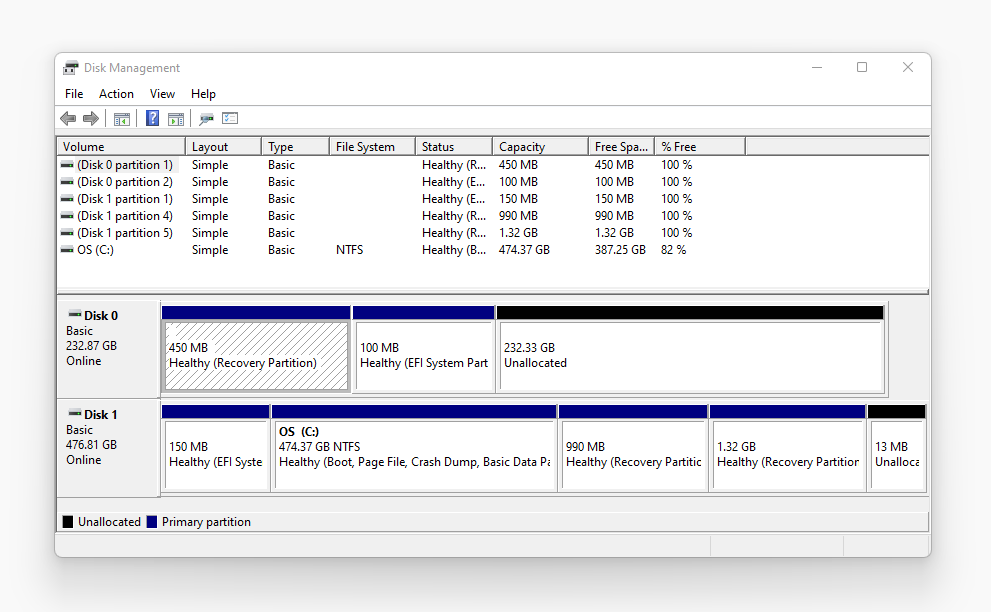Today I just added an old SSD to a Windows machine to use it as a back up drive. With old disks, usually they come with existing data, and I wanted to get rid of it. The problem is I couldn’t figure out how to do this using the Disk Management, the native GUI application used to manage disks.

The problem could be simple to Windows users. Basically, when I right-clicked on the 2 partitions (450 MB and 100 MB) on Disk 0, there is no option to remove them.
So I turned to google and looked up how to do this using Windows PowerShell instead. Here is how to delete disk partitions on a Windows machine using PowerShell [1].
- List all disks attached to the machine:
PS C:\Users\kenno> Get-Disk
Number Friendly Name Serial Number HealthStatus OperationalStatus Total Size Partition
Style
------ ------------- ------------- ------------ ----------------- ---------- ----------
1 PM991 NVMe... 3530_3930_4E90_1131_0025_3846... Healthy Online 476.94 GB GPT
0 Samsung SS... S21MNXAG919148N Healthy Online 232.89 GB GPT
- I wanted to delete existing partitions from Disk 0. First, let’s list all partitions of Disk 0.
PS C:\Users\kenno> Get-Partition -DiskNumber 0
DiskPath: \\?\scsi#disk&ven_samsung&prod_ssd#4&2e0052d9&0&000000#{53f56307-b6bf-11d0-94f2-00a0c91efb8b}
PartitionNumber DriveLetter Offset Size Type
--------------- ----------- ------ ---- ----
1 1048576 450 MB Recovery
2 472907776 100 MB System
3 577765376 16 MB Reserved
- Great. Let’s delete partition number 1 of Disk 0.
PS C:\Users\kenno> Remove-Partition -DiskNumber 0 -PartitionNumber 1
Confirm
Are you sure you want to perform this action?
This will erase all data on disk 0 partition 1.
[Y] Yes [A] Yes to All [N] No [L] No to All [S] Suspend [?] Help (default is "Y"):
- Verify if the partition 1 has been deleted.
PS C:\Users\kenno> Get-Partition -DiskNumber 0
DiskPath: \\?\scsi#disk&ven_samsung&prod_ssd#4&2e0052d9&0&000000#{53f56307-b6bf-11d0-94f2-00a0c91efb8b}
PartitionNumber DriveLetter Offset Size Type
--------------- ----------- ------ ---- ----
2 472907776 100 MB System
3 577765376 16 MB Reserved
Great! Repeat step 3 for partitions 2 and 3 of Disk 0.
Finally, let’s list the partitions of Desk 0 again.
PS C:\Users\kenno> Get-Partition -DiskNumber 0
Get-Partition : No MSFT_Partition objects found with property 'DiskNumber' equal to '0'. Verify the value of the
property and retry.
At line:1 char:1
+ Get-Partition -DiskNumber 0
+ ~~~~~~~~~~~~~~~~~~~~~~~~~~~
+ CategoryInfo : ObjectNotFound: (0:UInt32) [Get-Partition], CimJobException
+ FullyQualifiedErrorId : CmdletizationQuery_NotFound_DiskNumber,Get-Partition
So that’s it. If I were a Windows system administrator, I think PowerShell would be an indispensable tool, and have no excuse to get very good with it.
Bonus:
As I mentioned earlier, my intention is to use the secondary disk as a backup disk. Therefore, I will still need to create a new volume on it after removing all existing partitions. At this stage, I can use the Disk Management tool to create a new simple volume by right-clicking on the “Unallocated” space of Disk 0. However, let’s do this using PowerShell command too. Details information can be found at [2].
PS C:\Users\kenno> New-Partition -DiskNumber 0 -UseMaximumSize | Format-Volume -FileSystem NTFS -NewFileSystemLabel Data
DriveLetter FriendlyName FileSystemType DriveType HealthStatus OperationalStatus SizeRemaining Size
----------- ------------ -------------- --------- ------------ ----------------- ------------- ----
Data NTFS Fixed Healthy OK 232.79 GB 232.88 GB
Here is the new partition created on Disk 0.
PS C:\Users\kenno> Get-Partition -DiskNumber 0
DiskPath: \\?\scsi#disk&ven_samsung&prod_ssd#4&2e0052d9&0&000000#{53f56307-b6bf-11d0-94f2-00a0c91efb8b}
PartitionNumber DriveLetter Offset Size Type
--------------- ----------- ------ ---- ----
1 1048576 232.88 GB Basic
Note: I just realized that I could have performed a different operation to remove all existing partitions on a disk in few PowerShell commands after reading guide from link [2]. Oh well, it doesn’t matter, ‘cuz in the end I still got a new volume (data) created, and get to learn a few tricks with PowerShell.
References: